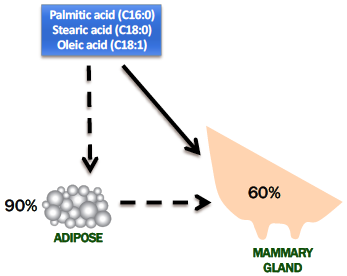Targeted Fatty Acid Supplementation
Targeted Fatty Acid Supplementation
Dairy cows may not have a specific dietary fat requirement, however, specific fatty acids (FA) in the diet can improve:
- Yield of milk and milk components
- Maintenance of body condition
- Nutrient digestion
- Nutrient partitioning
- Reproduction and health
 However, commercial FA supplements remain among the most expensive ingredients in the ration. So, cost-effective use amounts to targeting beneficial effects of specific FA while avoiding detrimental knock-on effects.
However, commercial FA supplements remain among the most expensive ingredients in the ration. So, cost-effective use amounts to targeting beneficial effects of specific FA while avoiding detrimental knock-on effects.
“A bag of fat is not just a bag of fat,” says Michigan State’s Dr. Adam Lock . “You cannot know what to expect from feeding it without — at minimum — knowing its FA profile.”
Commercial fat supplements typically make use of palmitic (PA, C16:0), stearic (SA, C18:0), and oleic (OA, C18:1) FA. Particular physical forms, such as prills or Ca-salts, can offer advantages in handling, mixing, and feeding. Various blends can target specific stages in the lactation cycle.
FA for transition
As for fresh cows, previously nutritionists generally avoided feeding supplemental FA because of FA from lipolysis already circulating in blood. There was a risk of lower dry matter intake offsetting any advantage of increased energy density in the diet.
“Previous research results are contradictory about the benefits of FA supplementation in early lactation,” Lock notes. “Likely reasons include differences in FA profile of supplements, inclusion rates, and the start time for supplementation in the lactation cycle.”
Palmitic-oleic blends
More recent research, Lock says, has focused on targeted FA supplementation in the transition period and carry-over effects into peak lactation. For example, studies at Michigan State tested PA-OA blends in a range of concentrations (80% C16:0 + 10% C18:1; 70% C16:0 + 20% C18:1; 60% C16:0 + 30% C18:1) as combinations of prills and Ca-salts.
Feeding FA supplements containing PA and OA increased DM, NDF, and FA digestibility, energy intake, milk yield, and ECM. Moreover, increasing C18:1 in the supplement increased DM, NDF, and FA digestibility, reduced plasma NEFA and BW and BCS losses, and tended to increase DMI and plasma insulin. Also, the yield of milk and milk components, 3.5% FCM, and ECM were higher during the carryover period.
In practice, considering whether to use FA supplements and which FA to use are key.
“It remains important,” Lock cautions, “to consider possible effects of FA in the rumen, in the small intestine, in the mammary gland, and energy partitioning between tissues.”
Questions?
Email FeedInsight 4Dairy

